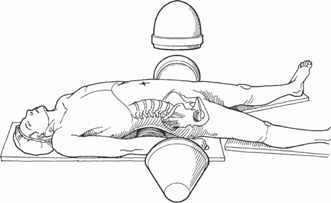63
Laparoscopic Surgical Technique
Harvinder S. Sandhu
Description
Availability of surgical instruments and advances in minimally invasive surgical techniques have enabled surgeons to use laparoscopic methods to access the anterior lumbar spine. The first reported laparoscopic approach for lumbar diskectomy was performed by T.G. Obenchain in 1991. The first two cases of anterior L5-S1 fusion via a laparoscopic approach were performed in September 1993 by J. Zuckerman et al. A variety of interbody implants, such as titanium cages, carbon cages, and allograft, have been utilized to provide stability across the intravertebral segment. These devices permit restoration of lordosis and disk space height and provide immediate intervertebral fixation via the flexion-distraction concept. The techniques are potentially demanding and involve a significant learning phase.
Indications
Laparoscopic anterior fusion is indicated for reconstituting the foraminal volume (indirect decompression), increasing lordosis, obtaining fusion of the symptomatic degenerative spinal motion segment, and obtaining fusion following posterior pseudarthrosis.
Contraindications
Because adhesions might prevent safe and adequate exposure, patients with previous abdominal surgery are generally not ideal candidates for laparoscopic exposure of the spinal column.
Key Procedural Steps
The technique involves accessing the anterior disk space, allowing disk removal, and distraction across the intravertebral space. The space is then prepared for placement of the fixation implant. Frequent fluoroscopic assessment is done throughout the procedure.
The technique involves the following steps:
- Preoperative planning
- Operating room setup
- Positioning of the patient
- Access
- Intraoperative localization and templating
Preoperative Planning
Preoperative planning is performed to facilitate accurate implant placement. Computed tomography (CT) or magnetic resonance imaging (MRI) scans are mandatory to evaluate the location of the vessels (superior vena cava, aorta, and the common iliac arteries and veins) and their respective bifurcations, and to plan the optimal and safest approach.
The preoperative preparation requires that patients be treated with a routine mechanical large bowel prep to empty the sigmoid colon.
Operating Room Setup and Patient Positioning and Equipment
General anesthesia is utilized, and a Foley catheter and a nasogastric tube are inserted. The patient is placed in the supine position on a radiolucent operating table. Narrow folded blankets or inflatable supports are placed underneath the pelvis to elevate the spine, to increase lordosis, and to obtain better visualization with the C-arm fluoroscope. Furthermore, careful placement of both forearms at the sides and below the level of the spine, or across the chest, or suspended using finger traps is performed to clear the forearms from the C-arm lateral view (Fig. 63.1). The standard laparoscopic equipment is utilized, including a 0- and 30-degree 10-mm endoscope, camera, light source, CO 2 insufflator, and two monitors to provide visualization for two surgeons on either side of the table. The patient is then placed in a steep Trendelenburg position using straps to prevent the patient from sliding. This position allows the bowel to fall cephalad, providing an unobstructed view of the lumbosacral spine. The patient may be placed in the supine closed leg position with the surgeons at the sides of the patient or may be placed in a split leg position with the primary surgeon positioned between the legs. The split leg position may be preferable if the spine surgeon wishes to gain a midline caudad to cephalad orientation of the lumbar spine.

Stay updated, free articles. Join our Telegram channel

Full access? Get Clinical Tree







